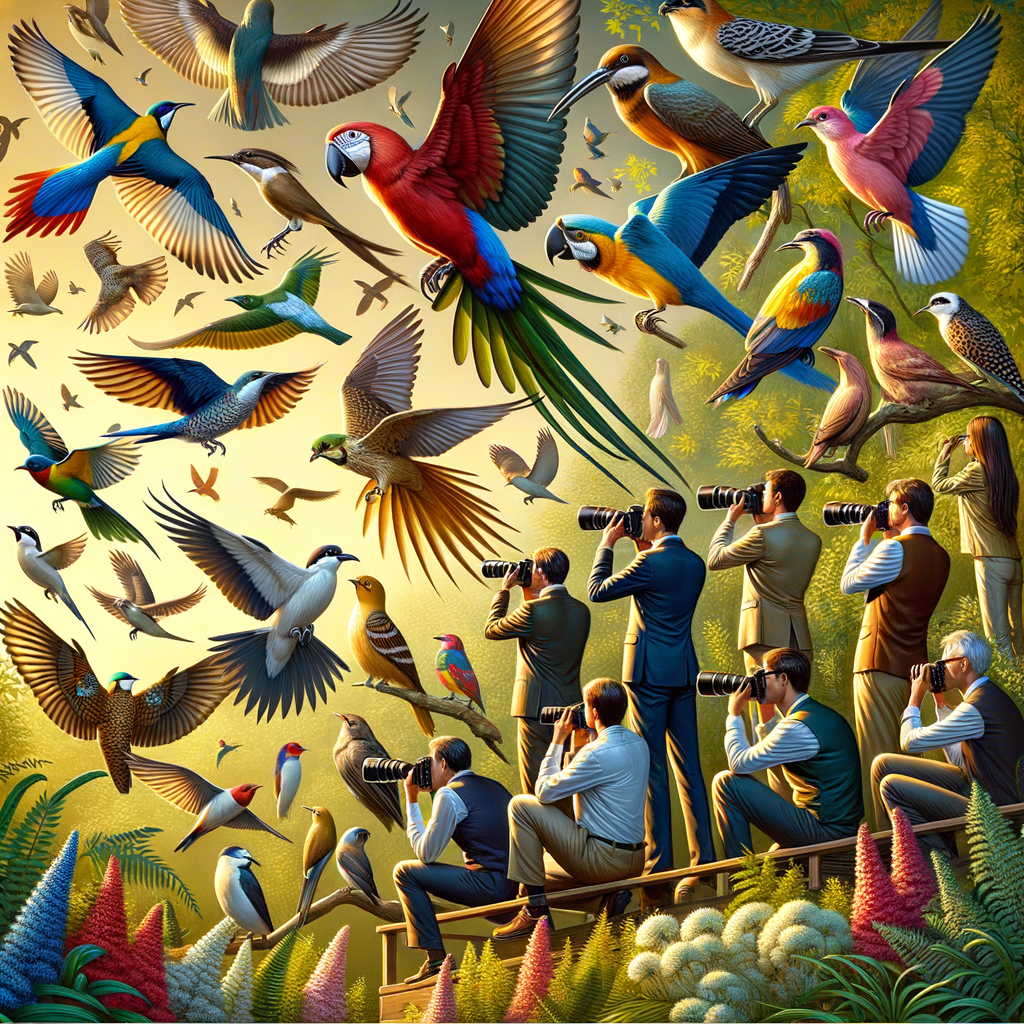
Introduction to Endangered Species
Our planet is home to an amazing array of life, from the smallest insects to the largest mammals. However, many of these species are in danger of disappearing forever. This is where the concept of endangered species comes into play. But what exactly does it mean for a species to be endangered, and why is it so important to conserve biodiversity? Let’s dive in and find out.
- Understanding the concept of endangered species
- Importance of biodiversity conservation
An endangered species is a type of animal, plant, or other organism that is at serious risk of becoming extinct. This can happen for a variety of reasons, such as loss of habitat, climate change, or hunting. According to the International Union for Conservation of Nature (IUCN), there are currently over 30,000 species that are considered to be endangered. This includes many species of birds, which we will be focusing on in this article.
Biodiversity refers to the variety of life on Earth, in all its forms and interactions. It is what makes our planet vibrant and full of life. However, when species become endangered and potentially go extinct, it can have a significant impact on biodiversity. This is because each species plays a unique role in its ecosystem, and the loss of one species can disrupt the balance of the entire system.
Conserving biodiversity is not just about protecting individual species. It’s about preserving the intricate web of life that supports us all. It ensures the natural sustainability of all life forms and maintains a healthy and functional ecosystem. Plus, it’s also about safeguarding the future of our own species. After all, we rely on biodiversity for many things, from food and medicine to clean air and water.
In the following sections, we will take a closer look at some specific examples of endangered bird species, the role of bird conservation in protecting these species, and how you can get involved in bird watching to learn more about these incredible creatures.
Spotlight on Rare Birds: Winged Wonders of the World
Our planet is home to a diverse array of bird species, each with its unique characteristics and habitats. However, some of these winged wonders are facing the threat of extinction. Let’s take a closer look at some of these rare and endangered birds.
Profiles of Rare and Endangered Bird Species
These bird species are not only rare but also critically endangered. Their survival is threatened by various factors such as habitat loss, climate change, and human activities. Let’s delve into the profiles of these unique bird species.
-
Case Study: The Kakapo of New Zealand
The Kakapo, also known as the owl parrot, is a nocturnal bird native to New Zealand. It’s the world’s heaviest parrot and, interestingly, it cannot fly. As of 2020, there are only about 200 Kakapos left in the wild. Their decline is mainly due to habitat loss and predation by introduced species.
-
Case Study: The California Condor
The California Condor is one of the world’s rarest bird species. This majestic bird, with a wingspan of up to 9.5 feet, was once on the brink of extinction. However, thanks to conservation efforts, their population has increased from just 27 birds in 1987 to over 400 today. Despite this, they remain critically endangered due to lead poisoning from ingesting spent lead ammunition.
-
Case Study: The Philippine Eagle
The Philippine Eagle, one of the world’s largest and most powerful birds of prey, is critically endangered. With a wingspan of up to 7 feet, this majestic bird is known for its striking appearance and powerful build. However, deforestation and hunting have led to a significant decline in their population, with less than 500 pairs believed to exist in the wild today.
These case studies highlight the urgent need for conservation efforts to protect these rare and endangered bird species. By understanding their plight, we can contribute to their survival and ensure that future generations can marvel at these winged wonders of the world.
The Role of Bird Conservation in Protecting Endangered Species
Conservation efforts play a crucial role in protecting endangered bird species. These efforts help maintain the balance of our ecosystem and preserve the beauty of our natural world. Let’s delve into the impact of these efforts and some success stories in bird conservation.
- Key Takeaway: The Impact of Conservation Efforts on Bird Populations
- Example: Success Stories in Bird Conservation
Conservation efforts have a significant impact on bird populations. These efforts help to protect birds from threats such as habitat loss, climate change, and pollution. By preserving their habitats and implementing measures to reduce these threats, we can help bird populations to thrive.
For instance, the Bald Eagle, once on the brink of extinction, has seen its population rebound thanks to concerted conservation efforts. In the 1960s, there were fewer than 500 nesting pairs of Bald Eagles in the U.S. Today, there are over 10,000 nesting pairs, a clear testament to the power of conservation.
There are many success stories in bird conservation that demonstrate the positive impact of these efforts. Let’s take a look at a few examples:
| Species | Conservation Effort | Result |
|---|---|---|
| Peregrine Falcon | Breeding programs and habitat protection | Removed from the U.S. Endangered Species List in 1999 |
| California Condor | Captive breeding and reintroduction programs | Population increased from 27 birds in 1987 to over 400 today |
| Whooping Crane | Protected habitats and breeding programs | Population increased from 21 birds in 1941 to over 600 today |
These success stories show how conservation efforts can help to protect and restore bird populations. They serve as a reminder of the importance of our role in preserving the natural world.
Endangered Bird Species and their Habitats
Our world is filled with a variety of beautiful and unique birds. However, many of these bird species are in danger of disappearing forever. Let’s take a closer look at these endangered birds and the places they call home.
Exploring the Habitats of Endangered Birds
Every bird species has a specific habitat where it thrives. These habitats provide the food, shelter, and resources birds need to survive. But what happens when these habitats are threatened?
- Understanding habitat loss and its impact on bird species
Habitat loss is a major threat to bird species worldwide. When forests are cut down, wetlands are drained, or grasslands are converted into farms, birds lose their homes. This loss of habitat can lead to a decrease in bird populations, and in some cases, can push species to the brink of extinction.
For example, the Ivory-billed Woodpecker, once common in the southeastern United States, is now considered possibly extinct due to extensive habitat loss. This bird relied on large, old-growth forests, which have largely been logged and converted to other uses.
- Case Study: The Amazon Rainforest and its bird species
The Amazon Rainforest is a prime example of a habitat that is critical for bird species. This vast forest is home to more than 1,300 species of birds, many of which are found nowhere else in the world.
However, the Amazon Rainforest is under threat from deforestation. Large areas of the forest are being cut down for logging, farming, and mining. This is causing a loss of habitat for many bird species, including the Harpy Eagle and the Amazonian Umbrellabird.
| Species | Status | Threats |
|---|---|---|
| Ivory-billed Woodpecker | Possibly extinct | Habitat loss due to logging |
| Harpy Eagle | Endangered | Habitat loss due to deforestation |
| Amazonian Umbrellabird | Vulnerable | Habitat loss due to deforestation |
As we can see, habitat loss is a major threat to bird species. By protecting and restoring habitats, we can help ensure the survival of these beautiful and unique creatures.
Bird Watching: An Encounter with Rare Animal Species
Have you ever wondered how a simple hobby like bird watching can contribute to the preservation of wildlife? It’s quite fascinating! Let’s delve into this topic and discover the role we can play as citizen scientists in bird conservation.
- How bird watching contributes to wildlife preservation
- Key Takeaway: The role of citizen scientists in bird conservation
Bird watching, also known as birding, is more than just a leisure activity. It plays a significant role in wildlife preservation. By observing birds in their natural habitats, bird watchers can gather valuable data about different bird species. This information can help scientists understand the behaviors, migration patterns, and population trends of these birds. It can also provide early warnings about environmental threats, such as habitat loss or climate change.
For instance, bird watchers have helped identify declining bird populations in certain areas. This has led to investigations and actions to protect these species and their habitats. In this way, bird watching contributes to wildlife preservation.
Every bird watcher can be a citizen scientist, contributing to bird conservation. Citizen scientists are regular people who help scientists collect and analyze data. In the field of bird conservation, citizen scientists play a crucial role. They provide valuable data about bird species, their habitats, and their behaviors. This data is often used in research and conservation efforts.
For example, the annual Christmas Bird Count, one of the longest-running citizen science projects, has been collecting data on bird populations for over a century. This data has been instrumental in understanding the long-term health and status of bird populations across North America.
In conclusion, bird watching is not just a hobby. It’s a way for us to connect with nature and contribute to its preservation. So, the next time you’re out bird watching, remember – you’re not just enjoying the beauty of these winged wonders. You’re also playing a part in protecting them for future generations.
Conclusion: The Future of Bird Conservation
As we come to the end of our journey exploring the world of endangered birds, it’s important to look ahead and consider the future of bird conservation. This involves understanding the challenges and opportunities that lie ahead, as well as recognizing the role each of us can play in protecting these winged wonders.
- Challenges and opportunities in protecting endangered bird species
One of the biggest challenges in bird conservation is habitat loss. As forests are cut down and wetlands are drained for human use, birds lose the places they need to live and breed. Climate change also poses a significant threat, altering the habitats that birds depend on.
However, these challenges also present opportunities. Conservationists are finding innovative ways to protect and restore habitats, from reforesting areas to creating artificial nesting sites. Technological advancements are also playing a role, with drones and satellite imagery being used to monitor bird populations and track their movements.
- How individuals can contribute to bird conservation efforts
While the challenges may seem daunting, there is much that individuals can do to contribute to bird conservation. Simple actions like setting up bird feeders or nesting boxes in your backyard can provide valuable resources for local bird species. Participating in citizen science projects, such as bird counts, can also provide important data for conservation efforts.
Another way to contribute is by supporting conservation organizations. These groups work tirelessly to protect endangered species and their habitats, and they rely on donations and volunteers to carry out their work. By giving your time or resources, you can make a real difference in the future of bird conservation.
In conclusion, the future of bird conservation will undoubtedly be filled with challenges, but also with opportunities. By understanding these issues and taking action, we can all play a part in ensuring that the beauty and diversity of our bird species are preserved for generations to come.






